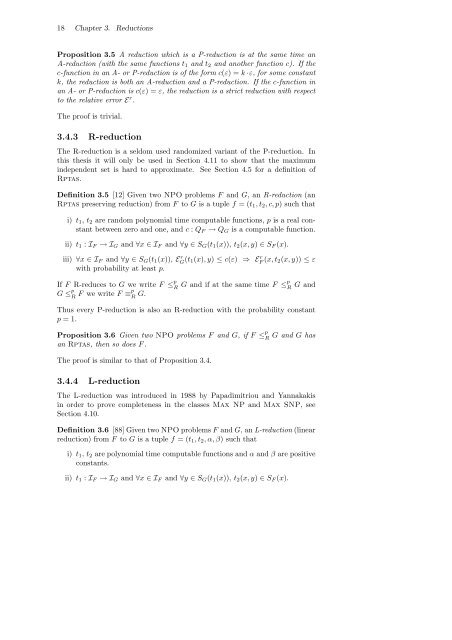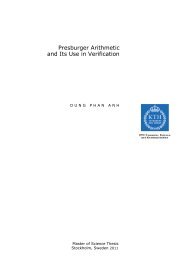On the Approximability of NP-complete Optimization Problems
On the Approximability of NP-complete Optimization Problems
On the Approximability of NP-complete Optimization Problems
Create successful ePaper yourself
Turn your PDF publications into a flip-book with our unique Google optimized e-Paper software.
18 Chapter 3. Reductions<br />
Proposition 3.5 A reduction which is a P-reduction is at <strong>the</strong> same time an<br />
A-reduction (with <strong>the</strong> same functions t1 and t2 and ano<strong>the</strong>r function c). If <strong>the</strong><br />
c-function in an A- or P-reduction is <strong>of</strong> <strong>the</strong> form c(ε) =k ·ε,for some constant<br />
k,<strong>the</strong> reduction is both an A-reduction and a P-reduction. If <strong>the</strong> c-function in<br />
an A- or P-reduction is c(ε) =ε,<strong>the</strong> reduction is a strict reduction with respect<br />
to <strong>the</strong> relative error E r .<br />
The pro<strong>of</strong> is trivial.<br />
3.4.3 R-reduction<br />
The R-reduction is a seldom used randomized variant <strong>of</strong> <strong>the</strong> P-reduction. In<br />
this <strong>the</strong>sis it will only be used in Section 4.11 to show that <strong>the</strong> maximum<br />
independent set is hard to approximate. See Section 4.5 for a definition <strong>of</strong><br />
Rptas.<br />
Definition 3.5 [12] Given two <strong>NP</strong>O problems F and G, anR-reduction (an<br />
Rptas preserving reduction) from F to G is a tuple f =(t1,t2,c,p) such that<br />
i) t1, t2 are random polynomial time computable functions, p is a real constant<br />
between zero and one, and c : QF → QG is a computable function.<br />
ii) t1 : IF →IG and ∀x ∈IF and ∀y ∈ SG(t1(x)), t2(x, y) ∈ SF (x).<br />
iii) ∀x ∈IF and ∀y ∈ SG(t1(x)), E r G (t1(x),y) ≤ c(ε) ⇒ E r F (x, t2(x, y)) ≤ ε<br />
with probability at least p.<br />
If F R-reduces to G we write F ≤ p<br />
G ≤ p<br />
R<br />
F we write F ≡p<br />
R G.<br />
R<br />
G and if at <strong>the</strong> same time F ≤p<br />
R G and<br />
Thus every P-reduction is also an R-reduction with <strong>the</strong> probability constant<br />
p =1.<br />
Proposition 3.6 Given two <strong>NP</strong>O problems F and G,if F ≤ p<br />
R G and G has<br />
an Rptas,<strong>the</strong>n so does F .<br />
The pro<strong>of</strong> is similar to that <strong>of</strong> Proposition 3.4.<br />
3.4.4 L-reduction<br />
The L-reduction was introduced in 1988 by Papadimitriou and Yannakakis<br />
in order to prove <strong>complete</strong>ness in <strong>the</strong> classes Max <strong>NP</strong> and Max S<strong>NP</strong>, see<br />
Section 4.10.<br />
Definition 3.6 [88] Given two <strong>NP</strong>O problems F and G, anL-reduction (linear<br />
reduction) from F to G is a tuple f =(t1,t2,α,β) such that<br />
i) t1, t2 are polynomial time computable functions and α and β are positive<br />
constants.<br />
ii) t1 : IF →IG and ∀x ∈IF and ∀y ∈ SG(t1(x)), t2(x, y) ∈ SF (x).

















